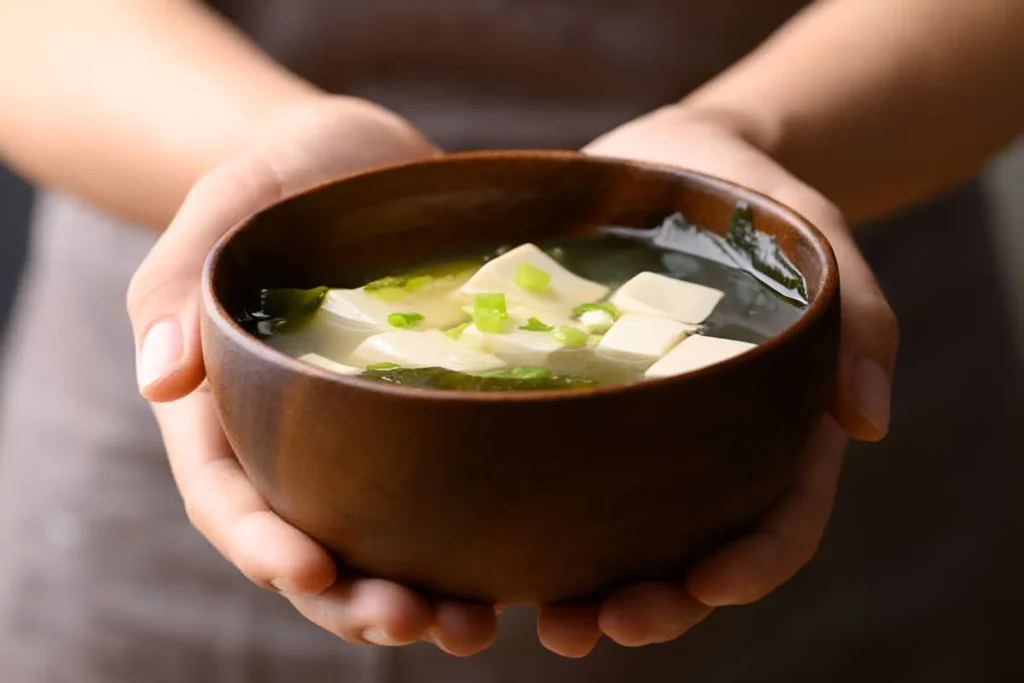Discover the Best Miso Soup Recipe: Ultimate Umami Flavor

Explore the world of Japanese cooking with miso soup. It’s a dish that has been loved for centuries. It’s more than just food; it’s a way to connect with your family’s past through its delicious flavors and traditional ways of making it.
Making miso soup lets you peek into Japan’s true culinary world. Every spoonful shares stories of local ingredients, special cooking methods, and family traditions. These stories have been passed down through generations in Japan.
If you love cooking or just want to learn about Japanese food, this guide is for you. You’ll learn about the ingredients, how to make it, and why it’s so important in Japanese culture.
Key Takeaways
- Miso soup is a fundamental component of traditional Japanese cuisine
- Understanding authentic preparation techniques is key
- Regional variations offer unique flavors
- Miso soup is very nutritious
- Choosing the right ingredients is essential for a great soup
Understanding the Cultural Significance of Miso Soup in Japanese Cuisine
Miso soup is more than just a dish in Japanese culture. It carries centuries of tradition, social bonds, and health wisdom. These elements have shaped Japanese society for ages.
In Japanese cuisine, miso soup is key to daily nutrition. It brings people together through shared experiences and eating habits.
Historical Origins of Miso in Japanese Society
Miso soup’s history goes back to the Heian period (794-1185 CE). Buddhist monks introduced fermented soybean paste then. It became vital for nutrition in those early times.
- Originated as a preserved food for warriors and monks
- Developed complex fermentation techniques
- Became a staple of Japanese dietary culture
Traditional Role in Japanese Daily Life
Miso soup is more than food in Japanese homes. It’s a ritual of nourishment. It connects families through meals and shared culinary knowledge.
| Meal Type | Miso Soup Significance |
|---|---|
| Breakfast | Essential morning nutrition |
| Lunch | Comfort and balanced meal component |
| Dinner | Family gathering and cultural tradition |
Cultural Practices and Customs Around Miso Soup
Japanese culture values miso soup deeply. It’s served at ceremonies and family meals. This dish shows warmth, care, and cultural identity.
- Served in traditional ceramic bowls
- Prepared with seasonal ingredients
- Symbolizes hospitality and familial love
Miso soup is a strong symbol of Japan’s rich culinary history. It connects old traditions with today’s health knowledge.
Essential Ingredients for Traditional Miso Soup
Discovering what’s in miso soup uncovers its traditional Japanese charm. The main ingredients mix together to create a flavorful blend that has been loved for ages.
The heart of traditional tofu miso soup lies in a few key parts. Let’s look at the essential elements that turn simple items into a culinary work of art:
- Dashi Stock: The base that adds depth and umami flavor
- Miso Paste: The core of the soup, bringing a rich, fermented taste
- Tofu: Soft, silken cubes that add protein and texture
- Wakame Seaweed: Delicate green ribbons that add minerals
- Green Onions: Fresh garnish that adds brightness
Each ingredient is vital in making the perfect miso soup. The art of balancing flavors is a tradition passed down through generations of Japanese cooks.
| Ingredient | Nutritional Benefit | Flavor Profile |
|---|---|---|
| Miso Paste | Probiotics, Protein | Umami, Salty |
| Tofu | Protein, Calcium | Mild, Creamy |
| Wakame | Iodine, Minerals | Subtle Sea Flavor |
| Green Onions | Vitamin K, Antioxidants | Sharp, Fresh |
“In Japanese cuisine, miso soup is more than a dish—it’s a celebration of simple, pure ingredients.” – Traditional Japanese Chef
When making your tofu miso soup, remember that quality matters. Choose fresh, authentic ingredients to truly enjoy this Japanese classic.
Types of Miso Paste and Their Unique Characteristics
Exploring miso soup starts with knowing the different miso pastes. Each type has its own taste and uses in cooking. Choosing the right miso can make your soup special.
Miso paste is made from fermented soybeans. It’s key to making real miso soup. The way it’s made affects its taste, color, and how you use it in cooking.
White Miso (Shiro Miso)
White miso is the mildest and sweetest. It has more rice and is fermented for less time. It’s great for beginners because of its gentle flavor.
- Lightest color among miso varieties
- Shortest fermentation period
- Mild, slightly sweet taste
- Best for delicate soups and dressings
Yellow Miso (Shinshu Miso)
Yellow miso has a balanced taste. It’s good for traditional miso soup. It has a richer flavor than white miso.
- Medium fermentation time
- Balanced saltiness
- Adaptable to various cooking styles
- Popular in many Japanese households
Red Miso (Aka Miso)
Red miso is the strongest and saltiest. It’s fermented the longest. It adds a deep umami flavor to your soup.
- Darkest color and strongest taste
- Longest fermentation period
- Most concentrated flavor profile
- Ideal for robust soup recipes
“The secret to an exceptional miso soup lies in understanding and selecting the right miso paste for your culinary creation.” – Japanese Culinary Experts
When picking miso paste, think about what you like and what recipe you’re making. Each type adds something special to miso soup.
The Art of Making Perfect Dashi Stock
Making miso soup starts with the perfect dashi stock. This key ingredient turns a simple recipe into a flavorful dish. It adds depth and umami to your Japanese soup.
Dashi is essential in Japanese cooking, like in miso soup. It’s made from two main ingredients:
- Kombu (dried kelp seaweed)
- Katsuobushi (dried bonito fish flakes)
To get authentic flavor, learn the traditional dashi method. Start by soaking kombu in cold water. Then, heat it slowly. Remove the kombu just before boiling and add bonito flakes. This creates a rich, flavorful stock for your miso soup.
For a vegetarian version, use:
- Shiitake mushrooms
- Kombu seaweed
- Dried kelp
Creating great dashi requires patience and care. Use low heat to bring out the best flavors. This way, your miso soup will taste like it’s from Japan, whether you’re a home cook or a chef.
Step-by-Step Guide to Making Basic Miso Soup
Making miso soup at home is simpler than you think. It just needs a few basic steps and good ingredients. Follow this guide to make a tasty Japanese dish in your kitchen.
- Dashi stock
- Miso paste
- Tofu (soft or firm)
- Green onions
- Wakame seaweed (optional)
Preparation Techniques
Heat your dashi stock in a medium saucepan over medium heat. Avoid boiling the stock to keep the flavors intact. Warm it until it’s steaming but not boiling.
Cooking Methods
To make your miso soup, add miso paste when the stock is off heat. Use a small whisk or strainer to mix it well. This avoids clumps and makes the soup smooth.
Serving Suggestions
Put your miso soup in traditional ceramic bowls right away. Top it with green onions and wakame seaweed for a real Japanese feel. Remember, freshness is key for the best taste.
Common Variations of Traditional Miso Soup

Exploring miso soup reveals a world of flavors. From traditional to creative, Japanese cuisine offers many variations. Each one can turn a simple dish into a culinary journey.
Tofu miso soup is a favorite among many. It adds protein with soft or firm tofu cubes. The tofu soaks up the miso broth, blending flavors perfectly.
- Classic vegetable miso soup with seasonal ingredients
- Seafood-enhanced miso soup with clams or shrimp
- Tofu miso soup with wakame seaweed
- Mushroom-infused miso soup variants
Regional differences make miso soup even more interesting. Each Japanese prefecture adds its own twist with local ingredients.
| Region | Unique Miso Soup Variation |
|---|---|
| Hokkaido | Seafood-rich miso soup with fresh salmon |
| Kyoto | Elegant miso soup with delicate vegetables |
| Okinawa | Tofu miso soup with local seaweed |
Trying different miso soup variations is a great way to explore Japanese cuisine. Whether you like a simple tofu version or a seafood-rich one, there’s something for everyone.
“Miso soup is not just a dish, it’s a canvas for culinary creativity.”
Seasonal Ingredients to Enhance Your Miso Soup
Changing your miso soup recipe with the seasons lets you enjoy new flavors. It makes your dish exciting and shows off Japanese cooking’s variety.
Knowing what’s in miso soup helps you make the perfect bowl for any season. This traditional Japanese dish is perfect for adding seasonal touches.
Spring and Summer Refreshing Additions
In warmer months, make your miso soup light and full of life. Try these ingredients to make it even better:
- Tender spring onions
- Fresh asparagus tips
- Delicate wakame seaweed
- Crisp sugar snap peas
- Soft tofu cubes
“A great miso soup reflects the season’s bounty and connects us to nature’s rhythm.” – Traditional Japanese Cooking Wisdom
Fall and Winter Hearty Components
As it gets cold, turn your miso soup into a cozy comfort food. Use these ingredients to add warmth and depth:
- Roasted kabocha squash
- Shiitake mushrooms
- Root vegetables like daikon radish
- Tender pieces of braised pork
- Hearty greens such as kale
Pro tip: Always add your miso paste at the end of cooking to preserve its delicate flavor and nutritional benefits.
Health Benefits and Nutritional Value of Miso Soup
Miso soup is a nutritional powerhouse that can greatly improve your health. It’s not just a tasty starter; it’s a meal full of vitamins and minerals.
The main ingredient, fermented soybean paste, has amazing health benefits. Adding tofu to miso soup boosts these benefits even more. It adds high-quality protein and more nutrients.
- Supports digestive health through probiotics
- Boosts immune system function
- Provides essential amino acids
- Reduces inflammation in the body
The nutritional value of miso soup can change based on ingredients. But most types offer great health benefits. The fermentation process makes nutrients more available, making miso soup a great diet addition.
| Nutrient | Amount per Serving | Health Benefit |
|---|---|---|
| Protein | 3-4 grams | Muscle repair and growth |
| Vitamin K | 10% daily value | Bone health and blood clotting |
| Manganese | 15% daily value | Metabolism and bone formation |
Adding miso soup to your diet regularly can help balance it. Especially when made with fresh tofu and seaweed, it’s a tasty way to meet your nutritional needs.
Tips for Selecting and Storing Miso Paste

Learning to make miso soup from paste starts with the right miso and storage. Miso paste is a delicate ingredient. It needs careful handling to keep its flavor and nutrition.
Quality Indicators to Consider
Choosing high-quality miso paste is important. Look for a few key things:
- Look for paste with a smooth, uniform texture
- Check for vibrant color without discoloration
- Seek organic or artisan-produced brands
- Verify the ingredient list for minimal preservatives
Optimal Storage Techniques
Storing miso paste right is key. Cold storage keeps its flavor rich and prevents spoilage.
- Refrigerate immediately after opening
- Use an airtight container
- Keep away from direct light and heat sources
- Seal the container tightly after each use
Understanding Shelf Life
Miso paste’s shelf life depends on its type and storage. Unopened miso can last months to a year. Opened miso should be used in 3-6 months for best taste.
Follow these tips to keep your miso paste fresh and tasty for all your Japanese cooking.
Regional Miso Soup Specialties Across Japan
Exploring miso soup in Japan shows a world of flavors unique to each region. Your journey will reveal amazing tastes that highlight local ingredients and cooking methods.
In Hokkaido, the north, miso soup is bold. It’s filled with fresh seafood and root veggies. Here, you might find salmon, potatoes, and strong miso, making it perfect for cold weather.
- Hokkaido: Seafood-rich miso soup with salmon and potatoes
- Kyoto: Delicate miso soup featuring subtle vegetable combinations
- Tohoku: Hearty versions with mountain vegetables
- Okinawa: Tropical-influenced miso soup with local seaweed
Kyoto’s miso soup is a world apart. Elegant and refined, it focuses on balance and seasonal ingredients. Chefs here see miso soup as a form of art, choosing each element with care.
“In Japan, miso soup is more than a dish – it’s a reflection of regional identity and cultural heritage.” – Japanese Culinary Expert
Tohoku’s miso soup includes wild veggies and herbs from the mountains. Okinawa’s version is tropical, with seaweed and unique ingredients that make it stand out.
Knowing about these variations helps you see the richness of Japanese food traditions. Every spoonful of miso soup shares a story of local culture and cooking.
Common Mistakes to Avoid When Making Miso Soup
Making the perfect miso soup needs focus and knowing what to avoid. Even skilled cooks can face issues. Knowing these mistakes helps you make a tasty, true Japanese dish.
Learning to make miso soup is more than just mixing. It’s about avoiding common mistakes. Let’s look at the main areas where errors happen:
Temperature Control Challenges
Controlling heat is key when making miso soup. Boiling miso kills its good bacteria and changes its taste. Here’s how to do it right:
- Remove the pot from heat before adding miso paste
- Stir miso gently at low temperatures
- Aim for warm, not boiling, liquid
Ingredient Balance Difficulties
Getting the right mix of ingredients is vital. The wrong mix can make the soup taste bad or too salty.
| Ingredient | Recommended Proportion | Common Mistake |
|---|---|---|
| Miso Paste | 1-2 tablespoons per cup | Using too much or too little |
| Dashi Stock | 4-5 cups | Diluting or concentrating excessively |
| Additional Ingredients | Moderate amounts | Overcrowding the soup |
Storage and Preservation Errors
Storing miso soup right is key to keeping it fresh and safe. Never reheat miso soup multiple times. It loses its good taste and nutrients. Eat it within 1-2 days and keep it in the fridge in a sealed container.
Knowing these mistakes helps you make miso soup better. You’ll enjoy a real Japanese dish in your kitchen.
Pairing Miso Soup with Other Japanese Dishes
Miso soup is key in traditional Japanese meals. It brings together flavors and nutrition in a balanced way. Pairing tofu miso soup with other dishes can make your meal special.
Japanese meals often start with miso soup. Its umami taste pairs well with many classic dishes. This makes for a complete and enjoyable meal.
- Steamed rice as a foundational dish
- Grilled fish or seafood
- Tempura vegetables or proteins
- Pickled vegetable side dishes
- Sashimi or sushi rolls
Your tofu miso soup can be the star of the show. It goes well with many proteins and vegetables. Its light, warm taste is perfect as a starter or with richer Japanese dishes.
Think about the season when choosing your ingredients. A winter miso soup might go great with grilled mackerel. A summer version could pair well with sashimi and cold veggies.
The art of Japanese cuisine lies in creating balance and harmony on the plate.
Try out different pairings to find your favorite miso soup match. Enjoy the rich traditions of Japanese cooking.
Modern Interpretations and Fusion Recipes
Modern chefs have turned traditional miso soup into exciting dishes. They mix global flavors with this Japanese classic. Now, you can try new fusion recipes.
Chefs add unexpected ingredients from around the world to miso soup. They mix things up to make the dish more interesting:
- Mexican-inspired miso soup with chipotle and corn
- Mediterranean fusion featuring roasted garlic and herb variations
- Italian-style miso soup with sun-dried tomatoes and basil
- Thai-influenced coconut milk and lemongrass miso soup
When making these new recipes, chefs keep the traditional dashi base. But they add global ingredients to make it unique. Your miso soup can be a creative project, mixing old and new flavors.
Some restaurants serve miso soup in new ways, like as a deconstructed dish or appetizer. This shows how versatile it can be. It encourages home cooks to try their own versions too.
“Fusion is about respect for tradition and innovative spirit” – Chef Masaharu Morimoto
Whether you love cooking or just enjoy eating, these modern miso soup recipes are fun. They let you explore new tastes while respecting Japanese cuisine’s heritage.
Tools and Equipment for Perfect Miso Soup
Making authentic miso soup is more than just using ingredients. The right tools can change your cooking experience. Whether you’re cooking at home or are a food lover, the right utensils will improve your Japanese cooking.
To make miso soup, you need to know which kitchen tools are best. You don’t need a lot, but a few key items can make a big difference.
Essential Utensils for Miso Soup Preparation
- Donabe or Clay Pot: Traditional Japanese ceramic pot perfect for gentle heating
- Wooden Spoon: Ideal for stirring miso paste without scratching cookware
- Fine Mesh Strainer: Helps dissolve miso paste smoothly
- Sharp Kitchen Knife: For precisely chopping garnishes and ingredients
- Measuring Cups: Ensures accurate ingredient proportions
Optional Equipment to Enhance Your Cooking
- Japanese Dashi Whisk: Specialized tool for mixing stock and miso
- Digital Kitchen Scale: Provides precise ingredient measurements
- Ceramic Ladle: Traditional serving implement for authentic presentation
- Temperature-Controlled Kettle: Helps maintain ideal soup temperature
Investing in quality tools will make making miso soup more fun and authentic. Remember, the right equipment can turn a simple recipe into a special culinary experience.
Conclusion
Your journey into miso soup shows a tradition that’s more than just a recipe. This iconic Japanese dish is a mix of nutrition, flavor, and culture. A great miso soup recipe invites you to dive into Japanese cuisine’s depth.
Trying different miso paste, seasonal ingredients, and cooking methods shows its versatility. Whether you’re cooking at home or love food, mastering miso soup is exciting. Each bowl connects you to Japan’s cooking history.
Making authentic miso soup is about balance and respect for ingredients. Start with basic steps, learn from old ways, and make your own recipe. Its simplicity and flexibility let you make it your own while keeping its cultural roots.
Enjoy the warmth, nutrition, and comfort of a perfect miso soup bowl. Keep exploring, one delicious spoonful at a time.
FAQ
What exactly is miso soup?
Miso soup is a traditional Japanese soup. It’s made with dashi stock and miso paste. It often includes tofu, seaweed, and green onions. It’s a key part of Japanese meals, eaten at breakfast and throughout the day.
What types of miso paste are used in miso soup?
There are three main types of miso paste. White miso is mild and sweet. Yellow miso has a balanced flavor. Red miso is stronger and more intense. Each type adds a unique flavor to the soup.
Is miso soup healthy?
Yes, miso soup is very healthy. It has probiotics from fermentation. It’s also rich in minerals and vitamins. It supports digestion and is low in calories. The fermented miso paste boosts your immune system.
How do I make authentic miso soup at home?
To make authentic miso soup, you need dashi stock and miso paste. You can add tofu, wakame seaweed, and green onions if you like. Heat the dashi, then carefully dissolve the miso paste. Add your ingredients and keep the temperature gentle to preserve the miso’s nutrients.
Can vegetarians or vegans eat miso soup?
Yes, vegetarians and vegans can enjoy miso soup. Use vegetable-based dashi stock instead of traditional bonito flake stock. Many miso pastes are plant-based, making it easy to make a meat-free version.
How long can I store miso paste?
Miso paste can last a long time when stored right. An unopened container can last up to a year. Opened miso paste stored in an airtight container in the fridge can last 6-12 months. Always check for spoilage before using.
What are some common variations of miso soup?
There are many variations of miso soup. Some include clams, different vegetables, shiitake mushrooms, and daikon radish. Modern versions might add corn, potatoes, or protein alternatives for unique flavors.
Is miso soup only consumed in Japan?
While miso soup started in Japan, it’s now enjoyed worldwide. Restaurants, health cafes, and home cooks around the globe have adopted it. They adapt it to local tastes and ingredients.
Add a Dash of Your Thoughts!
There are no reviews yet. Be the first one to write one.






